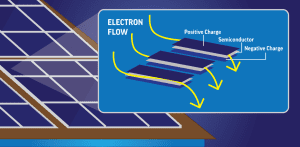Few people are aware of the real science involved in the conversion of sunlight into usable power by solar photovoltaic (PV) panels.
We will get into the specific science of solar this week on the blog.
The photovoltaic effect, or the capacity of materials to emit electrons when exposed to light, is what drives everything, despite how convoluted it may seem.
Let’s take a high-level look at the fundamental flow of electricity production before going any farther down to the molecular level:
Basic Solar Energy Production and Transmission Steps
- Solar panels are illuminated by sunlight, which produces an electric field.
- The produced power enters a conductive wire at the panel’s edge.
- The electrical current is carried by the conductive wire to the inverter, which converts it from DC electricity to AC, which is utilized to power structures.
- The AC energy is sent from the inverter through a different line to the electric panel on the property (also known as a breaker box), which then distributes it as required throughout the building.
- Any power generated that is not immediately required enters the utility system via the utility meter. The meter runs backwards as the power passes through it, crediting your property for any surplus production.
Let’s explore the science underlying the solar photovoltaic panel in more detail now that we have a fundamental understanding of the production and flow of solar power.
The Mechanism of Solar PV Cells

Numerous tiny photovoltaic cells, which are photovoltaic in the sense that they can turn sunlight into energy, make up solar PV panels.
These cells are constructed from semi-conductive substances, most often silicon, which may conduct electricity while preserving the necessary electrical imbalance for the generation of an electric field.
The solar PV cell absorbs light energy in the form of photons when sunlight strikes the semiconductor (step 1 in our high-level overview), which releases a number of electrons that then float about the cell freely.
The solar cell’s positively and negatively charged semiconductors are placed together in a certain way to produce an electric field (see the image to the left for a visualization).
The conductive metal plates that line the cell’s interior are forced to receive the electrons’ drifting motion in a particular direction by this electric field.
The amount of electricity that each cell can generate depends on the strength of this flow, which is referred to as an energy current.
The current is then guided through wires, enabling the unbound electrons to flow as they would in any other source of electric generating once they contact metal plates (step 2 in our process).
Energy from the solar panel’s electric current travels over a network of cables to an inverter (see step 3 above).
While direct current (DC) energy is produced by solar panels, the majority of electricity users need alternating current (AC) electricity to operate their structures.
The purpose of the inverter is to convert DC power into AC electricity so that it may be used in daily life.
The electrical panel, also known as a breaker box, receives the electricity once it has been converted into a useable form (AC power) in step 4 and distributes it as necessary throughout the structure.
Solar energy may now be used to easily power lights, appliances, and other electrical equipment.
Through the utility meter, any power that is not used through the breaker box is delivered to the utility grid (our last step, as outlined above).
Electricity flowing from the grid to your house and vice versa is measured by the utility meter.
This meter really goes backwards when your solar energy system is generating more power than you are consuming locally, and you get rewarded for the extra electricity produced via the process of net metering.
You use this meter to draw more power from the grid when you are utilizing more energy than your solar panel system is producing.
This allows the meter to function correctly.
You will need to use some electricity from the grid, particularly at night when your solar array is not generating, unless you have entirely disconnected from the grid using a storage system.
However, a large portion of this grid energy will be replaced by the extra solar energy you produce during the day and during off-peak hours.
Even though the science underlying solar is quite complex, anybody can see the advantages a solar installation may have for a company or property owner.
An expert solar developer can explain these advantages to you and assist you in determining if a solar solution is appropriate for your company.










